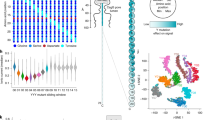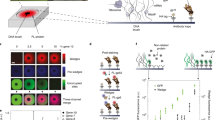Abstract
The most challenging step in protein microarray fabrication is high-throughput production of proteins. Here we report two similar strategies to fabricate protein chips through capture onto a solid surface of the nascent polypeptides during translation of synthetic or in vitro–transcribed RNAs. Using these approaches, we efficiently fabricated both peptide and protein microarrays at relatively high density. We further demonstrated that such protein chips can be used to analyze protein activity.
This is a preview of subscription content, access via your institution
Access options
Subscribe to this journal
Receive 12 print issues and online access
$209.00 per year
only $17.42 per issue
Buy this article
- Purchase on Springer Link
- Instant access to full article PDF
Prices may be subject to local taxes which are calculated during checkout


Similar content being viewed by others
References
Gao, L.Z. & Innan, H . Science 306, 1367–1370 (2004).
Ross-Macdonald, P. et al. Nature 402, 413–418 (1999).
Martin, J. et al. Nature 432, 988–994 (2004).
MacBeath, G. & Schreiber, S.L. Science 289, 1760–1763 (2000).
Haab, B.B., Dunham, M.J. & Brown, P.O . Genome Biol. 2 RESEARCH0004 (2001).
Ptacek, J. et al. Nature 438, 679–684 (2005).
deWildt, R.M. et al. Nat. Biotechnol. 18, 989–994 (2000).
Zhu, H., Bilgin, M. & Snyder, M . Annu. Rev. Biochem. 72, 783–812 (2003).
Ramachandran, N. et al. Science 305, 86–90 (2004).
Liu, R. et al. Methods Enzymol. 318, 268–293 (2000).
Zhu, H. et al. Science 293, 2101–2105 (2001).
Xu, L. et al. Chem. Biol. 9, 933–942 (2002).
Hall, D. et al. Science 306, 482–484 (2004).
Harbison, C.T. et al. Nature 431, 99–104 (2004).
Zhu, J. & Zhang, M.Q . Bioinformatics 15, 607–611 (1999).
Acknowledgements
This research was supported by the National Institutes of Health (U54RR020839-01). We thank Jin Zhang for helpful discussions.
Author information
Authors and Affiliations
Contributions
S.C.T. performed all the experiments, H.Z. analyzed the data and both authors wrote the paper.
Corresponding author
Ethics declarations
Competing interests
The authors declare no competing financial interests.
Supplementary information
Supplementary Fig. 1
Protein chip fabrication. (PDF 1100 kb)
Supplementary Table 1
Oligos used in this study. (PDF 100 kb)
Supplementary Table 2
Effects of molar ratio of the BP oligo and synthetic peptide RNAs on the on-chip in vitro translation. (PDF 112 kb)
Rights and permissions
About this article
Cite this article
Tao, SC., Zhu, H. Protein chip fabrication by capture of nascent polypeptides. Nat Biotechnol 24, 1253–1254 (2006). https://doi.org/10.1038/nbt1249
Received:
Accepted:
Published:
Issue Date:
DOI: https://doi.org/10.1038/nbt1249
This article is cited by
-
Spatial regulation of synthetic and biological nanoparticles by DNA nanotechnology
NPG Asia Materials (2015)
-
Functional protein microarray: an ideal platform for investigating protein binding property
Frontiers in Biology (2012)
-
Protein Microarrays: Novel Developments and Applications
Pharmaceutical Research (2011)
-
New technologies in cancer. Protein microarrays for biomarker discovery
Clinical and Translational Oncology (2011)
-
A proteome chip approach reveals new DNA damage recognition activities in Escherichia coli
Nature Methods (2008)



